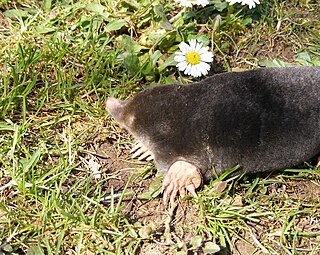
Moles are small mammals adapted to a subterranean lifestyle. They have cylindrical bodies, velvety fur, very small, inconspicuous eyes and ears, reduced hindlimbs, and short, powerful forelimbs with large paws adapted for digging.

Golden moles are small insectivorous burrowing mammals endemic to Sub-Saharan Africa. They comprise the family Chrysochloridae and as such they are taxonomically distinct from the true moles, family Talpidae, and other mole-like families, all of which, to various degrees, they resemble as a result of evolutionary convergence. There are 21 species. Some are relatively common, whereas others are rare and endangered.
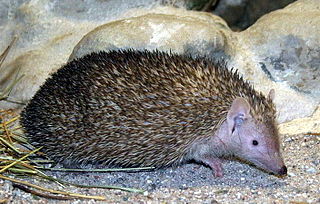
The clade Afrosoricida contains the golden moles of Southern Africa, the otter shrews of equatorial Africa and the tenrecs of Madagascar. These three groups of small mammals were for most of the 19th and 20th centuries regarded as a part of the Insectivora or Lipotyphla, but both of those groups, as traditionally used, are polyphyletic.

Juliana's golden mole is a golden mole endemic to South Africa. It is listed as an endangered species due to habitat loss and a restricted range. Golden moles are an ancient group of mammals that live mostly below ground. The eponymous Juliana is Juliana Meester, the wife of the South African zoologist who named this species.
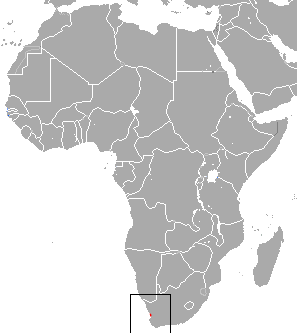
Van Zyl's golden mole is a golden mole endemic to the Western Cape Province, South Africa. It is listed as an endangered species due to habitat loss. Golden moles are an ancient group of mammals who live mostly below ground. They have shiny coats of dense fur and a streamlined, formless appearance. They have no visible eyes or ears; in fact, they are blind – the small eyes are covered with hairy skin. The ears are small and are hidden in the animal's fur.
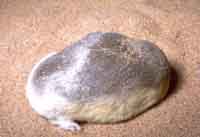
Grant's golden mole is a golden mole species. It is the only member of the genus Eremitalpa.

The giant golden mole is a small mammal found in Africa. At 23 centimetres (9.1 in) in length, it is the largest of the golden mole species. This mole has dark, glossy brown fur; the name golden comes from the Greek word for green-gold, also the source of the name of the family, Chrysochloridae.

The wildlife of South Africa consists of the flora and fauna of this country in Southern Africa. The country has a range of different habitat types and an ecologically rich and diverse wildlife, vascular plants being particularly abundant, many of them endemic to the country. There are few forested areas, much savanna grassland, semi-arid Karoo vegetation and the fynbos of the Cape Floristic Region. Famed for its national parks and big game, 297 species of mammal have been recorded in South Africa, as well as 849 species of bird and over 20,000 species of vascular plants.

Amblysomus is a genus of the golden mole family, Chrysochloridae, comprising five species of the small, insect-eating, burrowing mammals endemic to Southern Africa. All five species can be found in South Africa and some are also found in Eswatini and Lesotho.

The Hottentot golden mole is a species of mammal in the golden mole family, Chrysochloridae. It is found in South Africa, Eswatini, and possibly Lesotho. Its natural habitats are temperate forests, subtropical or tropical dry and moist lowland forest and dry shrubland and grassland, Mediterranean-type shrubby vegetation, savanna, temperate grassland, sandy shores, arable land, pastureland, plantations, rural gardens, and urban areas.

The Congo golden mole is a species of mammal in the family Chrysochloridae. It is found in Angola, Cameroon, Central African Republic, Republic of the Congo, and Democratic Republic of the Congo. Its natural habitats are subtropical or tropical forest, arable land, pastureland, plantations, and rural gardens.
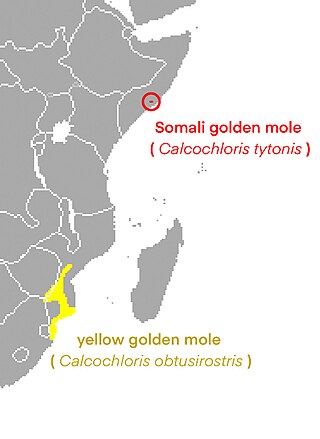
Calcochloris is a genus of mammal in the family Chrysochloridae. It contains the following species:

The yellow golden mole is a species of mammal in the family Chrysochloridae. It is found in Mozambique, South Africa, and Zimbabwe. The yellow golden mole's natural habitats are subtropical or tropical dry and moist lowland forests, savanna, arable land, pasture, plantations, and rural gardens.

Duthie's golden mole is a species of mammal in the family Chrysochloridae. It is endemic to South Africa. Its natural habitats are subtropical or tropical moist lowland forests, moist savanna, temperate grassland, arable land, pastureland, plantations, rural gardens, and urban area. The specific name duthieae was given in honour of Dr. Augusta Vera Duthie, a South African botanist.

Chlorotalpa is a genus of mammal in the family Chrysochloridae. It contains the following species:

Chrysochloris is a genus of mammal in the family Chrysochloridae. It contains the following species:

The rough-haired golden mole is a species of mammal that live mostly below ground. They have shiny coats of dense fur and a streamlined, formless appearance. They have no visible eyes or ears; in fact, they are blind - the small eyes are covered with hairy skin. The ears are small and are hidden in the animal's fur.

De Winton's golden mole is a species of mammal in the family Chrysochloridae. It is endemic to South Africa. Its natural habitats are subtropical dry shrubland, Mediterranean-type shrubby vegetation, and sandy shores. It is threatened by habitat destruction and is "critically endangered". It was named after British zoologist William Edward de Winton.
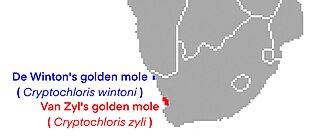
Cryptochloris is a genus of golden moles, containing the two species De Winton's golden mole and Van Zyl's golden mole.

The Maputaland-Pondoland-Albany Hotspot (MPA) is a biodiversity hotspot, a biogeographic region with significant levels of biodiversity, in Southern Africa. It is situated near the south-eastern coast of Africa, occupying an area between the Great Escarpment and the Indian Ocean. The area is named after Maputaland, Pondoland and Albany. It stretches from the Albany Centre of Plant Endemism in the Eastern Cape Province of South Africa, through the Pondoland Centre of Plant Endemism and KwaZulu-Natal Province, the eastern side of Eswatini and into southern Mozambique and Mpumalanga. The Maputaland Centre of Plant Endemism is contained in northern KwaZulu-Natal and southern Mozambique.




















